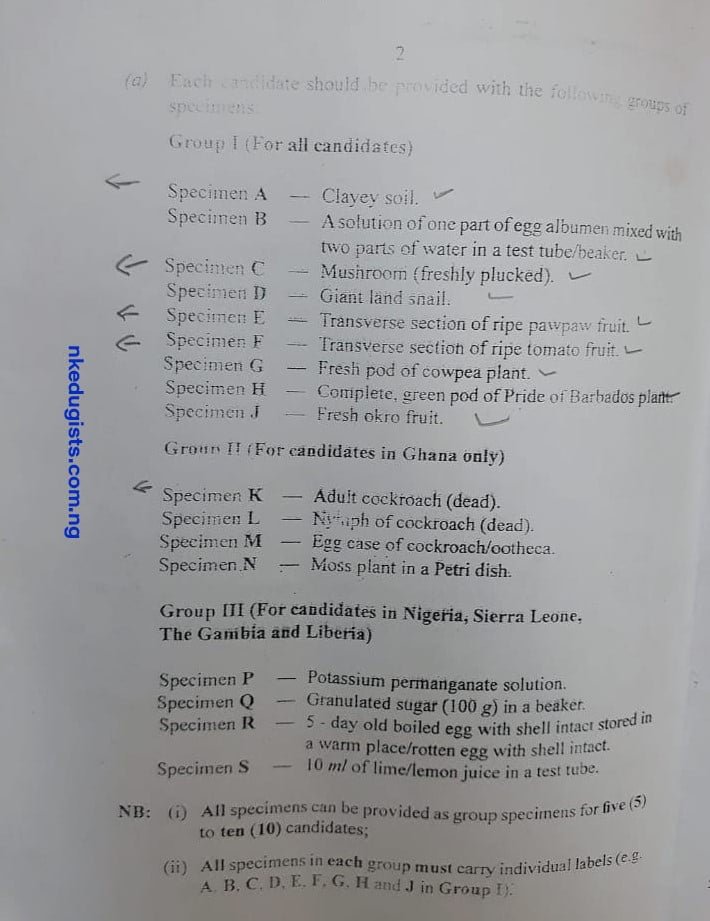2020 Waec Biology practical specimen Answer: If you are a candidate who is in search for 2020 Waec biology practical specimen answer then you are at the right website because we try to make sure all our audience study hard to pass with proper information.
Click here to see 2020 Waec Biology practical Question
Nkedugists don’t charge any fee for providing help or services to our audience, the only thing is to bookmark or subscribe to our website for you to have the latest updates. let get started with the 2020 waec biology practical specimen answer.
Specimen H – Complete green pod of Pride of Barbados Plant
The botanical name of Specimen H
It Is Caesalpinia Pulcherrima
Floral Part of Specimen H
I. Sepals/calyx
II . Petals / Corolla
III. Stamen/androecium
IV. Pistil / gynoecium
Structure of specimen H
- Flower are conspicuous /large
- Brightly coloured plants / greens
- Stigma is sticky
Domestic uses of specimen H
- it is used for beautification
- For medical purpose
- As a source f income
Economic Importance of Specimen H
- Environmental; Ornamental
- Medicines
- Vertebrate poisons; mammals
The symmetry of Specimen H
Bilateral/Bilaterally Symmetrical (because it can be cut into equal halves along only one plane)
Sex of Specimen H
Hermaphrodite/bisexual ( because it has both pistil / male and female organs /androecium and gynoecium).
Specimen H Diagram: Complete green pod of Pride of Barbados Plant

Complete green pod of Pride of Barbados Plant
Specimen E – Transverse Section of Ripe Paw Paw
Botanical name of Specimen E : Carica papaya
Classification of Specimen E
It is classified as a type of fleshy fruit
Structure of Specimen E
It consist of three layers which are
- Epicarp
- Mesocarp and
- Endocarp
N:B – The type of fleshy fruit of specimen E is berry
Economics Important of Specimen E
- It has a high nutritive and medicinal value
- it is used in the production of cosmetic beauty product
- They are good source of potassium
Mode of dispersal of specimen E
By small Animals
Check Related Article you need:
- 2020 WAEC PHYSICS PRACTICAL SPECIMENS FOR ALL CANDIDATE
- 2020 Waec Chemistry Practical Specimen Questions For all Candidates
- NKEDUGISTS FORUMS DISCUSSION COMMUNITY
Source of Food of Specimen E
Vitamin A and C
Characteristics of Specimen E
- They have pleasant aroma
- The skin colour of Specimen E range from green to yellow.
- Specimen E can be easy press with your thumb.
Specimen E Diagram: Transverse Section of Ripe Paw Paw

2020 Waec Biology practical specimen Answer
Specimen D – Giant land Snail
Habitat of Specimen D
Specimen D lives in shrublands, agricultural areas, plantations, garden, wetland e.t.c
Phylum – Mollusca
Class – Gastropoda
Observation Features that adapt Specimen D to its habitat
Lungs – Adapt to on land habitat through the use of lungs that take in oxygen.
Shells – for protection
Tentacles – for vision and feelings
Rasp tongue – for consumption and digestion
Foots – for movement inland habitat
Economic Importance of Specimen D
- They eat very low on the food web
- they provide food for all sorts of mammals, birds earthworm e.t.c
- They cause great disaster to farmers crop
- they consume rotten vegetation like most leaf.
Mode of the feeding of Specimen D
Is by Scraping and they mostly feed on leaves and insect
Sex of Specimen D
They exhibit Hermaphrodite / Bisexual (The snail with bigger shell are mainly female)
Specimen D Diagram: Gaint Land Snail

Specimen of Gaint Land Snail
Similarities Between Specimen F (tomatoes) and Specimen G (fresh pod of cowpea)
Both have annual life cycle
Both have seeds present
They both have plantation present
Differences Between Specimen F (tomato) and Specimen G (fresh pod of cowpea)
Specimen f (tomato) Specimen G (fresh pod of cowpea)
- Specimen F Is a fleshy fruit while Specimen G is a dry dehiscent fruit
- Specimen F Has axial placentation while Specimen G has a marginal placentation
- Specimen F Mode of dispersal is by an animal while Specimen G Mode of dispersal is by explosive mechanism
- Specimen F have Absence of epigeal germination while Specimen G presence of epigeal germination
Similarities Between Specimen E (pawpaw) and Specimen H (pride of Barbados plant)
- They both serves as a source of medicine
Differences Between Specimen E (pawpaw) and Specimen H (pride of Barbados plant)
Specimen E is a berry ( fleshy fruit) while Specimen H is a dry dehiscent fruit
Specimen E consists of epicarp, mesocarp, and endocarp while Specimen H consists of sepals, petals, stamen, pistil
Specimen E serves a source of refreshment while Specimen H serves as beautification
Specimen E colour range from green to yellow while Specimen H range from orange to
Specimen G – Fresh pod of cowpea plants
Botanical Name: Vigna Unguiciulata
Family: Fabaceae
Classification of Specimen G
Specimen G is classified as Dry fruit
Process of germination of specimen G
Germination of specimen G is exhibited by epigeal germination, i.e during germination, the cotyledons ( seed leaves) are carried above the soil
Economic Importance of Specimen G
- it serves as a source of food
- it serves as a source of income
- it is proteinous
- It is resistance to drought
- it helps to prevent erosion
The life cycle of specimen G
Life cycle: Annual
Placentation of Specimen G
It has marginal placentation e.g of fruit with similar placentation are soya beans, pride of Barbados and flamboyant
Uses of Specimen G
- the green seeds can be used as a substitute for coffee
- the leaves can also serve as vegetable dishes
- it can be used as green manure
Dispersal of Specimen G
The mode of dispersal of Specimen G is by an explosive mechanism
Specimen F – Transverse Section of ripe Tomato Fruit
Classification of Specimen F
Specimen F is classified as fleshy fruits ( fruit crops)
Botanical Name: Solanum Lycopersicum
Life Cycle of Specimen F
The life cycle is Annual
Structure of Specimen F
It consists of three layers which are
- Epicarp
- Mesocarp and
- Endocarp
N:B – The type of fleshy fruit of specimen E is berry
Placentation of Specimen F
It has Axial placentation e.g of fruit with similar placentation are garden egg, orange, pepper e.t.c
Mode of dispersal of Specimen F
It is mainly dispersed by Animals
Source of food by Specimen F
Vitamin
Uses of Specimen F
- Used for industrial purposes
- create employment opportunity
- serve as regeneration of source of income
Specimen F – Transverse Section of ripe Tomato Fruit

Specimen F – Transverse Section of ripe Tomatoe Fruit
If you need us to help you with more updated information at the right time about Waec questions/answer, kindly subscribe or bookmark our website for us to provide you with it.
If actually, this formation on “2020 Waec Biology practical specimen Answer” is helpful to you kindly share it to your friends and relative who also are students or aspirant using via Facebook, WhatsApp, Twitter and Google+







Great.
Always welcome
God bless you , I have been looking for this information since but I couldn’t find it . Thank you very much.
That’s awesome
Great, please can you help me with questions and answers for practical biology. Thank you
Please I need all the answer to the biology practical
Pls I want the full answer from Spp A.what step should I take?
The answer of practical biology questions
https://nkedugists.com.ng/2020-waec-biology-practical-specimen-answer/
Good and great work. God bless you always.
Thanks
Send me the biology practical answers
Please I would like to know what possible questions on specimens A,B,C,J,Q,R,S thanks for your help.I await ur reply
https://nkedugists.com.ng/2020-waec-biology-practical-specimen-answer/
I need specimen A B C J R S P Q of biology practical
We can’t find specimens J,Q,R and S
Good bless u I really appreciate your good work
Please what about I R S ????
this is the best online so far for WAEC questions and answers on all the subjects. Both practicals,theories and objectives.
Thanks.
it has reduce my browsing stress. Thank you.
Always welcome… Kindly subscribe to our website if have not.
Please how can i subscribe to your website
Kindly click the bell or allow our website to send you a notification
Sir what of the remaining specimen
Is already provided, kindly search it on our search engine.
Please I need specimen Q, R, S
Please I need all the answer to the biology practical for all the specimen
All subjects answer
This is great, thank you!
Please I need all questions answers for all specimens for 2020 waec biology practical
This is great, thank you!
Please I need all questions and answers for all specimens for 2020 waec biology practical
i need anwers to specimen J,p,Q ,T and S.
i need answers for group 3 specimen.and also specimen J
Thank you so much eh
I need specimen A B C J R S P Q of biology practical
Thank you very much
I need biology question
how does specimen F create employment opportunity
I need specimen S answers
specimen H range from orange to what colour. Please answer it fast
Thats so nice of u and its good to now that u have good interest for student’s at heart.
Good morning sir, thanks so much for the the biology practical, it really helped me. Will be very grateful if you will help me out for chemistry theory, obj, fishery practical and theory, thanks and God bless
We are sorry that we saw it late.. We have already help students that join our forum.